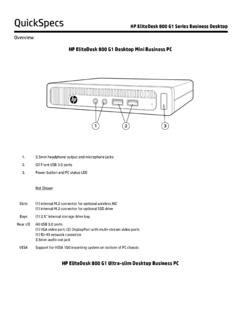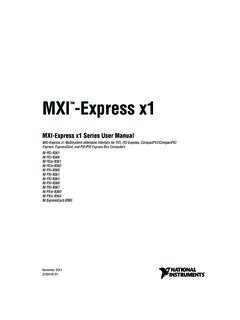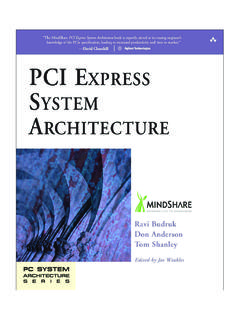Transcription of Dual PowerPC/Xilinx Virtex -II Pro Processing Engine
1 VPF1 Dual PowerPC/Xilinx Virtex -II Pro Processing EngineApplicationsRadarSonarElectronic warfare / signal intelligence / surveillanceReal-time imaging / inspection / machine visionMedical imaging FeaturesFPGA and PowerPC based processingDual Xilinx Virtex -II Pro XC VP70 FPGAsDual 744x PowerPC processors8x Serial I/O links operating up to 5 Gbps6U VXS/VITA 41 form factorAir or conduction cooled rugged versionsBenefi tsBalance of performance with ease of programmingPowerful and sophisticated PowerPC Processing powerFPGA options for optimal DSP or logic-centric designs with high-bandwidth communicationsIndustry standard form factorsFor use in deployed or commercial environments OverviewThe VPF1 is a modular signal and data Processing Engine that couples the power of the latest generation PowerPC CPUs, large Xilinx FPGAs and high-bandwidth multi-channel serial communication fabric to create a balanced and scalable compute , the VPF1 consists of four processor nodes; two nodes are based on the PowerPC 744x CPU and two nodes are based on the Xilinx Virtex -II Pro FPGA.
2 All processor nodes have a fully distributed memory structure with multiple inter-node communications channels. The communications fabric interconnects boards together as well as local processor elements for a scalable solution. The board is VXS compliant and able to handle Gbps backplane communications. The VPF1 can also be provided in a VME64x format, which is supplied without a VXS connector, as a factory build NodesXilinx Virtex -II Pro FPGAThe board s FPGA nodes use Xilinx Virtex -II Pro XC VP70 devices as standard, though other devices may be fi tted: contact VMETRO for details. Each node features:Eight .0 5 Gbps SERDES transceiver pairsFour banks of M x 18-bit QDR SRAMTwo banks of 64 Mbytes DDR SDRAMJTAG portGigabit Communication ChannelsThe Virtex -II Pro FPGAs feature serial communications, viaRocketIO transceivers, able to operate up to 5 Gbps.
3 The transceivers provide fast data links between VXS boards and between the board s local FPGAs: four RocketIO channels connect the two FPGA nodes and four channels from each FPGA are available for off-board (VXS) communications. Each RocketIO channel has separate LVDS pairs for receive and transmit signals. Groups of RocketIOs (from a single device) can be bonded together to synthesize fewer, but higher bandwidth data links if required. The serial communication bit rate is determined by a very low jitter reference oscillator, and is specifi ed at the time of express , Serial RapidIO & BeyondThe board s high-speed serial communications are compatible with standards and specifi cations based on VITA (VXS) to support Architecturally, the VPF1 consists of four processor nodes; two for a scalable solution.
4 The board is VXS compliant and able to VPF1 switch packet interfaces. The serial channels are electrically compliant with PCI express (PCIe), Serial RapidIO (sRIO) and other serial interfaces. Implementing these protocols requires suitable IP cores. The serial communications can also be used without protocols for stripped down, more efficient Memory BanksEach FPGA node includes four banks of Mx 18-bit QDR SRAM with read or write bandwidths of up to 500 Mbytes/s. As read and write transfers can take place concurrently, a total bandwidth of 1 Gbyte/s is available per QDR SRAM memory devices are directly linked to and controlled by the FPGAs.
5 This means that each QDR memory bank can be utilized to implement FIFO (or delay memory), linear addressable memory pool, bit-reversed addressing or circular buffer as best suits the application. Fast banks of SRAM are ideal for lookup tables, local data buffers and DSP operations such as concurrent (MAC) Multiply-Accumulate data Memory BanksBulk data storage for the FPGA nodes is provided through the dual 64 Mbyte SDRAM banks. These can be used to store large data-sets such as image frames for medical imaging or temporal Processing . Dual memory banks are also useful for decoupling I/O data streams allowing data to be processed more easily while the other bank is filling ConfigurationThe configuration file for each FPGA node is stored in the FLASH memory of the adjacent PowerPC node.
6 VMETRO supplies tools for programming the FPGA in both development and run-time environments. JTAG connectivity can also be used for FPGA development using Xilinx s optional ChipScope FPGA logic analyzer. An optional battery is available so that encrypted keys can be stored for secure FPGA Processor NodesOverviewA VPF1 includes two PowerPC 744x subsystems complete with SDRAM, FLASH, Ethernet, serial I/O ports, PCI interfaces and operating system support. Each PowerPC 744x node is available with 56 Mbytes of DDR SDRAM with ECC and is coupled via a MV64360 bridge and 64 Mbytes FLASH memory. The SDRAM is implemented with 72-bit data paths and clocked at off-board 100/1000 Mbit auto-negotiation Ethernet interfaces are provided, one from each PowerPC processor node, connected via the front panel 1000 BASE-T RJ45 connectors.
7 An Ethernet connection between the two PowerPC nodes is also provided. Alternatively, Ethernet can be routed to the VME P (EIA-422) & RS232 (EIA-232) InterfacesOne RS4 interface with RTS/CTS handshaking and one RS 3 port are provided per PowerPC node. These ports are routed to the VME P connector. Both ports are available for user applications and either can be used for a serial console as required by VxWorks for boot Timer, Temperature Sensors & Power MonitorsA hardware watchdog timer is provided and can be used to cause the board to reset and/or activate an interrupt if the watchdog is not serviced within a pre-defined period due to application failure.
8 Accessible via the PowerPC processor, the board includes sensors to monitor the temperature of the board and monitor the local supply InterfaceThe board features multiple, independent JTAG chains via Firecron JTS01/JTS06 controllers, accessible via both on-board PMCE thernetP2P0P1 PowerPCNode APowerPCNode BFPGANode AFPGANode BGbps serial I/O64-bit PCIGPIO64-bit64-bitPCI/PCIB ridgePCI/VMEB ridgeDevice BusDevice BusOptionXilinxVirtex-II ProXC2VP70 Architectural OverviewFPGA Processing Node3 VPF1 JTAG headers and the VME P connector. These connections also provide connectivity for the COP (PowerPC) and ChipScope/Agilent trace ports (FPGA) ports.
9 The separate JTAG chains permit the board to undergo dynamic diagnostic during normal application Site & FPGA Parallel I/OThe usual I/O data stream will be via the high-speed Gbps serial interfaces. However, the board also provides a 64-bit/66 MHz PMC for local I/O such as analog I/O or frame grabbers. The PMC site has a PMC user I/O connector routed to the VME P connector (build option) for backplane an alternative to PMC based backplane I/O, the VPF1 can use PMC user I/O (P14) to FPGA plus FPGA to VME P (rows a & c) I/O routing, which is useful for implementing custom interfaces such as LVDS. Whether these pins are PMC user I/O to VME P or direct FPGA connections is defined through a range of build & High-Speed Serial CommunicationsEach board has eight, off-board, multi-Gbps transceivers, each of which can be used to establish a point-to-point data link.
10 These links can be wired to create a wide range of topologies to best suit the application, such as pipelines of arrays, to smoothly scale the order to achieve the Gigabit speed data links, the board uses a MultiGig (RT ) type connector with balanced differential signal routing and ground planes. This connector (as outlined in the VITA 41/VXS specification) is not compatible with the standard VME P0 connector. VXS backplanes are based on the VME64x bus backplane with an alternative P0 connector designed to support Gbps differential serial VITA 41/VXS specification defines a standard P0 pin-out for the payload cards that is fabric independent.








